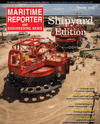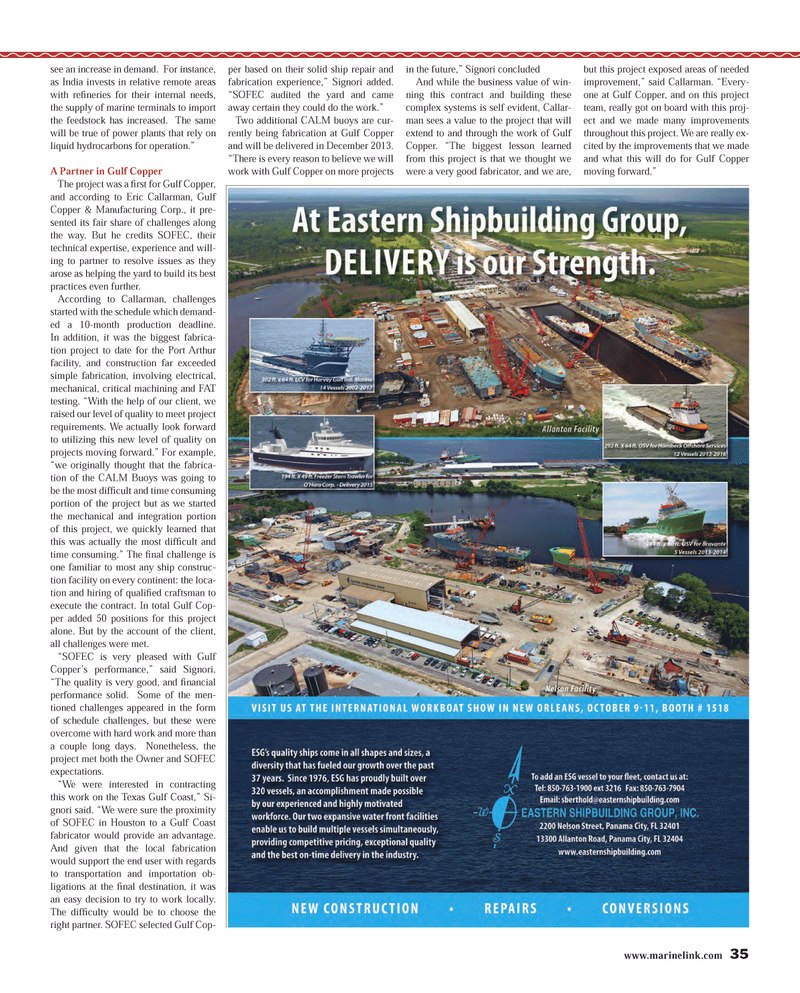
Page 35: of Maritime Reporter Magazine (August 2013)
Shipyard Edition
Read this page in Pdf, Flash or Html5 edition of August 2013 Maritime Reporter Magazine
www.marinelink.com 35see an increase in demand. For instance, as India invests in relative remote areas with reÞ neries for their internal needs, the supply of marine terminals to import the feedstock has increased. The same will be true of power plants that rely on liquid hydrocarbons for operation.? A Partner in Gulf Copper The project was a Þ rst for Gulf Copper, and according to Eric Callarman, Gulf Copper & Manufacturing Corp., it pre-sented its fair share of challenges along the way. But he credits SOFEC, their technical expertise, experience and will-ing to partner to resolve issues as they arose as helping the yard to build its best practices even further. According to Callarman, challenges started with the schedule which demand-ed a 10-month production deadline. In addition, it was the biggest fabrica-tion project to date for the Port Arthur facility, and construction far exceeded simple fabrication, involving electrical, mechanical, critical machining and FAT testing. ?With the help of our client, we raised our level of quality to meet project requirements. We actually look forward to utilizing this new level of quality on projects moving forward.? For example, ?we originally thought that the fabrica-tion of the CALM Buoys was going to be the most difÞ cult and time consuming portion of the project but as we started the mechanical and integration portion of this project, we quickly learned that this was actually the most difÞ cult and time consuming.? The Þ nal challenge is one familiar to most any ship construc-tion facility on every continent: the loca-tion and hiring of qualiÞ ed craftsman to execute the contract. In total Gulf Cop-per added 50 positions for this project alone. But by the account of the client, all challenges were met.?SOFEC is very pleased with Gulf Copper?s performance,? said Signori. ?The quality is very good, and Þ nancial performance solid. Some of the men-tioned challenges appeared in the form of schedule challenges, but these were overcome with hard work and more than a couple long days. Nonetheless, the project met both the Owner and SOFEC expectations.?We were interested in contracting this work on the Texas Gulf Coast,? Si- gnori said. ?We were sure the proximity of SOFEC in Houston to a Gulf Coast fabricator would provide an advantage. And given that the local fabrication would support the end user with regards to transportation and importation ob-ligations at the Þ nal destination, it was an easy decision to try to work locally. The difÞ culty would be to choose the right partner. SOFEC selected Gulf Cop- per based on their solid ship repair and fabrication experience,? Signori added. ?SOFEC audited the yard and came away certain they could do the work.?Two additional CALM buoys are cur- rently being fabrication at Gulf Copper and will be delivered in December 2013. ?There is every reason to believe we will work with Gulf Copper on more projects in the future,? Signori concluded And while the business value of win- ning this contract and building these complex systems is self evident, Callar- man sees a value to the project that will extend to and through the work of Gulf Copper. ?The biggest lesson learned from this project is that we thought we were a very good fabricator, and we are, but this project exposed areas of needed improvement,? said Callarman. ?Every-one at Gulf Copper, and on this project team, really got on board with this proj-ect and we made many improvements throughout this project. We are really ex- cited by the improvements that we made and what this will do for Gulf Copper moving forward.?MR #8 (34-41).indd 35MR #8 (34-41).indd 358/1/2013 11:08:55 AM8/1/2013 11:08:55 AM

 34
34

 36
36
